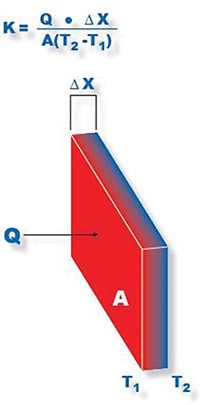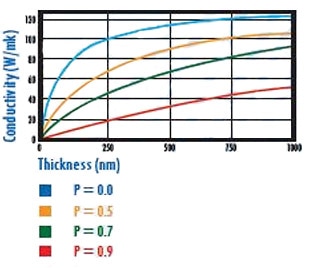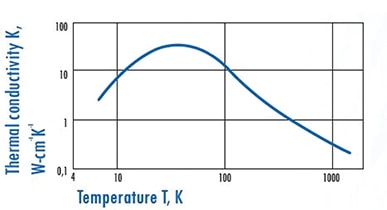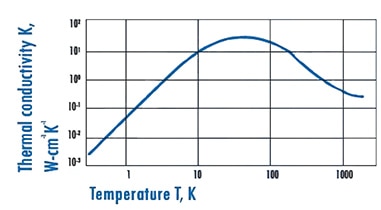Thermal Conductivity: What is it and Why You Should Care
2015-07-08
Thermal Conductivity: A measure of the ability of a material to transfer heat. Given two surfaces on either side of a material with a temperature difference between them, the thermal conductivity is the heat energy transferred per unit time and per unit surface area, divided by the temperature difference 1.
Thermal conductivity is a bulk property that describes the ability of a material to transfer heat. In the equation in Figure 1, thermal conductivity is the proportionality factor K. The distance of heat transfer is defined as rate of heat transferred through the material (Q), from temperature T1 to temperature T2, when T1>T2 2.

Figure 1: Conduction heat transfer process from hot (T1) to cold (T2) surfaces.
Thermal conductivity of materials plays a significant role in the cooling of electronics equipment; from the die where the heat is generated to the cabinet where the electronics are housed, conduction heat transfer and, subsequently, thermal conductivity, are the integral components of the overall thermal management process.
The path of heat from the die to the outside environment is a complicated process that must be understood when designing a thermal solution. In the past, many devices were able to operate without requiring an external cooling device like a heatsink. In these devices, the conduction resistance from the die to the board needed to be optimized, as the primary heat transfer path was into the PCB. As power levels increased, heat transfer solely into the board became inadequate. Much of the heat is now dissipated directly into the environment through the top surface of the component. In these new higher-powered devices, low junction-to-case resistance is important, as is the design of the attached heatsink.
To determine the importance of material thermal conductivity in a specific thermal management application (e.g. a heatsink), it is important to separate the overall thermal resistance associated with conduction heat transfer into three parts: interfacial, spreading, and conduction resistances.
Interface Material
An interface material enhances the thermal contact between imperfect mating surfaces. A highly thermally conductive material, with good surface wetting ability, will reduce interfacial resistance.
Spreading Resistance
Spreading resistance is used to describe the thermal resistance associated with a small heat source coupled to a larger heatsink. Among other factors, the thermal conductivity of the base of the heatsink directly impacts spreading resistance.
Conduction Resistance
Conduction resistance is a measure of the internal thermal resistance in a heatsink as heat travels from the base to the fins, where it dissipates into the environment. In regard to heatsink design, conduction resistance is less important in natural convection and low air flow conditions, becoming more important as flow rates increase.
Common units of thermal conductivity are W/mK and Btu/hr-ft-°F.
| Material | Bulk Conductivity (W/mk) |
| Silver, Pure | 418.0 |
| Copper 11000 | 388.0 |
| Aluminum 6061 T6 | 167.0 |
| Zinc, Pure | 112.2 |
| Iron, Cast | 55.0 |
| Solder, 60% Tin | 50.0 |
| Titanium | 15.6 |
| Thermal Grease, T660 | 0.90 |
| Fiberglass | 0.040 |
| Air, stp | 0.025 |
In the electronics industry, the constant push for smaller size and faster speeds has considerably reduced the scale of many components. As this transition now continues from the macro- to micro-scale, it is important to consider the effects on thermal conductivity and not to assume the bulk property is still accurate. Continuum-based Fourier equations cannot predict thermal characteristics at these smaller scales. More complete methods, such as the Boltzmann transport equation and the lattice Boltzmann method, are needed 3.
The effect of thickness on conductivity can be seen in Figure 2. The material characterized is silicon, which is widely used in electronics.

Figure 2: Thermal conductivity for silicon thin film 3.
Like many physical properties, thermal conductivity can be anisotropic depending on the material (directionally dependent). Crystalline and Graphite are two examples of such materials. Graphite has been used in the electronics industry where its high in-plane conductivity is valuable. Graphite crystals have very high in-plane conductivity (~2000 W/mK), due to the strong carbon-to-carbon bonding on their basal plane. The parallel basal planes are weakly bonded to each other, however, and the thermal conductivity perpendicular to these planes is quite low (~10 W/mK) 4.
Thermal conductivity is not only affected by changes in thickness and orientation; temperature also has an effect on the overall magnitude. Because of the material temperature increase, the internal particle velocity increases and so does thermal conductivity. This increased velocity transfers heat with less resistance. The Wiedemann-Franz law describes this behavior by correlating thermal and electrical conductivity to temperature. It is important to note that the effect of temperature on thermal conductivity is non-linear and hard to predict without prior research. The graphs below show the behavior of thermal conductivity over wide temperature ranges. Both of these materials, aluminum nitride and silicon, are used extensively in electronics (Figures 3 and 4, respectively).

Figure 3: Thermal conductivity of aluminum nitride as a function of temperature.

Figure 4: Thermal conductivity of silicon as a function of temperature 5.
In the future, higher-powered processors with multiple cores will push the need for improved thermal conductivity even further. Therefore, it is worthwhile to also investigate other areas of research and development in thermal conductivity enhancement for existing material used in electronics packages. One such area is the effect of nanotechnology on thermal conductivity, where carbon nanotubes have shown conductivity values near those of a diamond due to large phonon-mean-free paths 7. Development of new materials, and enhancement of existing materials, will result in more effective thermal management, as device power dissipation is on the steady rise.
This article first appeared in the Qpedia Thermal eNewsletter in October, 2011.
References:
- Thermal Conductivity, American Heritage Science Dictionary, Houghton Mifflin Company
- Moran, M. and Shapiro, H., Fundamentals of Engineering Thermodynamics, p 47, 1988
- Ghai, S., Kim, W., Chung, P., Amon, C., Jhon, M., Anisotropic Thermal Conductivity of Nanoscale Confined Thin Films Via Lattice Boltzmann, Chemical Engineering, Carnegie Mellon University, Nov. 2006
- Norley, J., The Role of Natural Graphite in Electronics Cooling, Electronics Cooling, August 2001
- Slack, G.A., Tanzilli R.A., Pohl R.O., Vandersande J.W.,J. Phys. Chem. Solids 48, 7 (1987), 641-647
- Glassbrenner, C. and Slack, G., Thermal Conductivity of Silicon and Germanium from 3°K to the Melting Point, Physical Review 134, 4A, 1964
- Berber, S., Kwon, Y., and Tomanek, D., Unusually High Thermal Conductivity of Carbon Nanotubes, Physical Review Letters, Vol 84, No 20, pp 4613-4616, 2000
免责声明:各个作者和/或论坛参与者在本网站发表的观点、看法和意见不代表 DigiKey 的观点、看法和意见,也不代表 DigiKey 官方政策。








